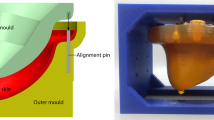Abstract
A number of biomechanical models have been proposed to improve nonrigid registration techniques for multimodal breast image alignment. A deformable breast model may also be useful for overcoming difficulties in interpreting 2D X-ray projections (mammograms) of 3D volumes (breast tissues). If a deformable model could accurately predict the shape changes that breasts undergo during mammography, then the model could serve to localize suspicious masses (visible in mammograms) in the unloaded state, or in any other deformed state required for further investigations (such as biopsy or other medical imaging modalities). In this paper, we present a validation study that was conducted in order to develop a biomechanical model based on the well-established theory of continuum mechanics (finite elasticity theory with contact mechanics) and demonstrate its use for this application.
Experimental studies using gel phantoms were conducted to test the accuracy in predicting mammographic-like deformations. The material properties of the gel phantom were estimated using a nonlinear optimization process, which minimized the errors between the experimental and the model-predicted surface data by adjusting the parameter associated with the neo-Hookean constitutive relation. Two compressions (the equivalent of cranio-caudal and medio-lateral mammograms) were performed on the phantom, and the corresponding deformations were recorded using a MRI scanner. Finite element simulations were performed to mimic the experiments using the estimated material properties with appropriate boundary conditions. The simulation results matched the experimental recordings of the deformed phantom, with a sub-millimeter root-mean-square error for each compression state. Having now validated our finite element model of breast compression, the next stage is to apply the model to clinical images.
Similar content being viewed by others
References
Augenstein KF, Cowan BR, LeGrice IJ, Nielsen PM, (2005) Method and apparatus for soft tissue material parameter estimation using tissue tagged magnetic resonance imaging. J Biomech Eng 127:148–157
Azar F, Metaxas D, Schnall M (2002) Methods for modeling and predicting mechanical deformations of the breast under external perturbations. Med Image Anal 6(1)
Bonet J, Wood RD (1997) Nonlinear continuum mechanics for finite element analysis. Cambridge University Press, Cambridge
Dronkers DJ, Hendriks JH, Holland R, Rosenbusch G (2002) The practice of mammography. Thieme
Fernandez J, Mithraratne P, Thrupp S, Tawhai M, (2004) Anatomically based geometric modelling of the musculo-skeletal system and other organs. Biomech Modell Mechanobiol 2(3):139–155
Fernandez JW (2004) An anatomically based finite element model of patella articulation: towards a diagnostic tool. PhD Thesis, University of Auckland
Laursen TA (2002) Computational contact and impact mechanics. Springer, Heidelberg
Nash MP, Hunter PJ (2000) Computational mechanics of the heart. J Elast 61:113–141
Puso MA, Laursen TA (2002) A 3D contact smoothing method using Gregory patches. Int J Numer Methods Eng 54(8):1161–1194
Rajagopal V, Nielsen PM, Nash MP (2003) A 3D finite element model of the breast to study breast cancer. In: World congress on medical physics and biomedical engineering
Rajagopal V, Chung JH, Bullivant DP, Nielsen PM, Nash MP (2005) Finite elasticity: determining the reference state from a loaded configuration. Int J Numer Methods Eng (submitted)
Rueckert D, Sonoda L, Hayes D, Hill D, Leach M, Hawkes D (1999) Nonrigid registration using free-form deformation: application to breast MR images. IEEE Trans Med Imag 18:712–721
Ruiter N, Stotzka R, Gemmeke H (2004) Model-based registration of X-ray mammograms and MR images of the female breast. In: IEEE nuclear science symposium and medical imaging conference
Ruiter NV (2003) Registration of X-ray mammograms and MR-volumes of the female breast based on simulated mammographic deformation. PhD Thesis, der Universitat Mannheim
Samani A, Bishop J, Yaffe M, Plewes D (2001) Biomechanical 3-D finite element modeling of the human breast using MRI data. IEEE Trans Med Imag 20(4):271–279
Schnabel J, Tanner C, Casterllano-Smith A, Degenhard A, Hose D, Hill D, Hawkes D (2003) Validation of nonrigid image registration using finite-element methods: application to breast MR images. IEEE Trans Med Imag 22(2)
Sylvia HK, Dershaw D, Schreer I (2001) Diagnostic breast imaging, 2nd edn. Thieme
Tanner C, Schnabel J, Degenhard A, Casterllano-Smith A, Leach M, Hose D, Hill D, Hawkes D (2002) Validation of volume-preserving non-rigid registration: application to contrast-enchanced MR-mammography. In: Lecture notes in Computer Science, MICCAI, vol 2489-I, pp 307–314
Tawhai M, Pullan A, Hunter P (2000) Generation of an anatomically based three-dimensional model of the conducting airway. Ann Biomed Eng 28:793–802
Wellman PS (1999) Tactile imaging. PhD Thesis, Harvard University
Wirth M (1999) A nonrigid approach to medical image registration: matching images of the breast. PhD Thesis, RMIT University
Author information
Authors and Affiliations
Corresponding author
Rights and permissions
About this article
Cite this article
Chung, J.H., Rajagopal, V., Nielsen, P.M.F. et al. A biomechanical model of mammographic compressions. Biomech Model Mechanobiol 7, 43–52 (2008). https://doi.org/10.1007/s10237-006-0074-6
Received:
Accepted:
Published:
Issue Date:
DOI: https://doi.org/10.1007/s10237-006-0074-6




